In country, designed by Joseph Miranda depicts 10 years of Vietnam
war as conventional war. He notes "US plans were initially predicated
on a conventional invasion ala Korea 1950."(Consim #72)
If the North had conducted a conventional campaign in 1965 (instead of
Tet), would US have won the war? Or, is there any effective way for US
to fight back NLF's unconventional warfare?
ジョセフ・ミランダデザインの「In Country」は、ベトナム戦争10年間を正規戦の視点から描いたゲームです。雑誌の付録ゲームとしては破格のサイズで、フルマップ二枚と、並べるだけで午前中いっぱいかかる2枚のカウンターシート。配置すると、マップの反対側のユニットは席を移動しないと見えない。
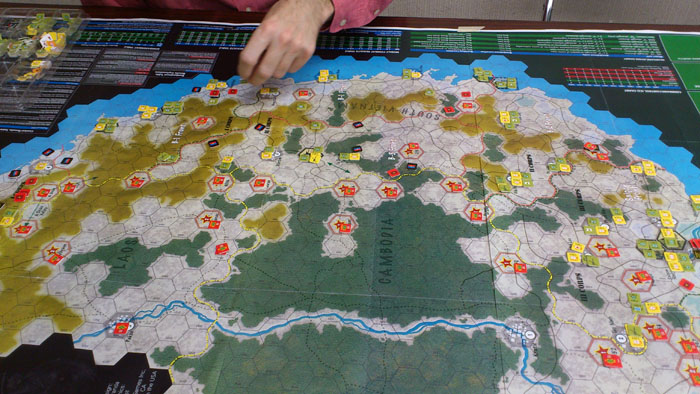
October 26, 2013: We played scenario Tet.
It deals with coordinated multi-front attacks by NLF. As is seen in the
below photo, battles everywhere. I felt as if I was playing 10s of small
interlinked games at the same time. We took about 2 hours to finish one
turn. That's means you may need a few days to play the entire scenario
(or you'll gotten tired of war.).
テト攻勢シナリオ:
マップのほぼ全域で戦闘が勃発しています。(何もないように見えるカンボジア領内ですら二個師団のNVAが活動している。)
一ターンに2時間かかり、全26ターンなので終了まで4日かかる計算になりますが、その前に25VP差がついてサドンデスになるでしょう。(あるいはその前に戦争に飽きる)
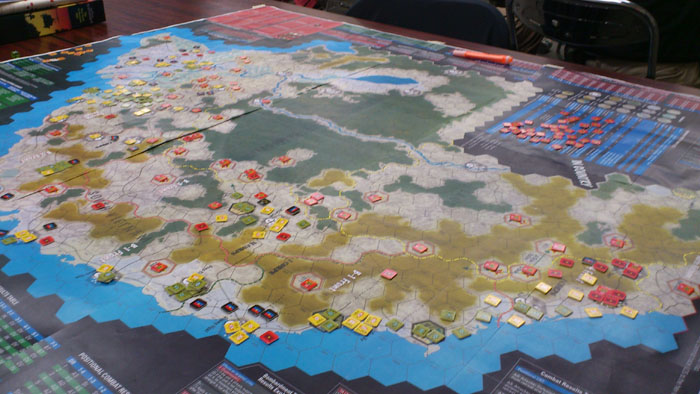
Khe Sanh in the 1st Communist turn. We exchanged the positions and played the both sides. Here's our conclusion, "US can't protect Khe Sanh, no matter how much he paid."
第一ターンのKhe Sanh周辺。米軍にはNVAの戦力が見えない。攻守を変えて二度対戦したわれわれの結論は「米軍はKhe Sanhを守れない」。
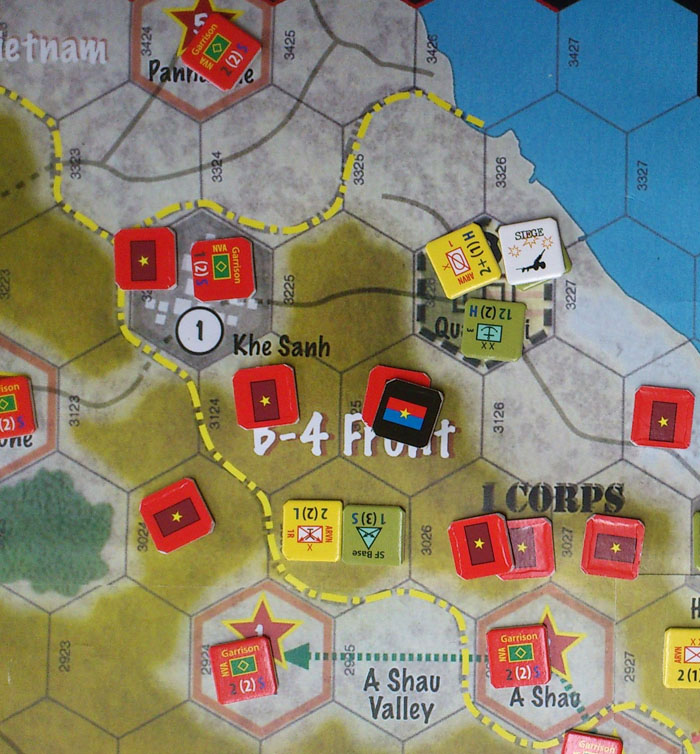
It's interesting situation that NLF, infantry oriented, with no air
power had initiative, while the US went after NLF, although US had unlimited
supply and overwhelming air support.
The Communist player can place his units almost any where in the map,
even adjacent US units. Before the first movement phase begins, cities
were surrounded by them. And more. Their attacks can be suicidal, for
the US player never gain political points by eliminating enemy units.
It's unconventional asymmetric war.
テト攻勢シナリオの特色は、空軍力皆無、歩兵編成のNVAが攻撃のイニシアチブを持ち、無制限の補給と空中機動力、攻撃力を持つ米軍が守勢に回ることにあります。
第一ターンではNVAが多大なアドバンテージを持つ。NVAは米軍の都市を次々と包囲、連隊以下の米軍拠点が次々と陥落します。しかし、それに続く米軍ターンでは、攻撃によって所在があきらかになったNVA/VCが、米軍空爆によって甚大な被害を受けるのです。米軍といえど南ベトナム全土をカバーするだけの兵力はないのですが、米軍が選んだ戦場では、NVAは100%壊滅します。
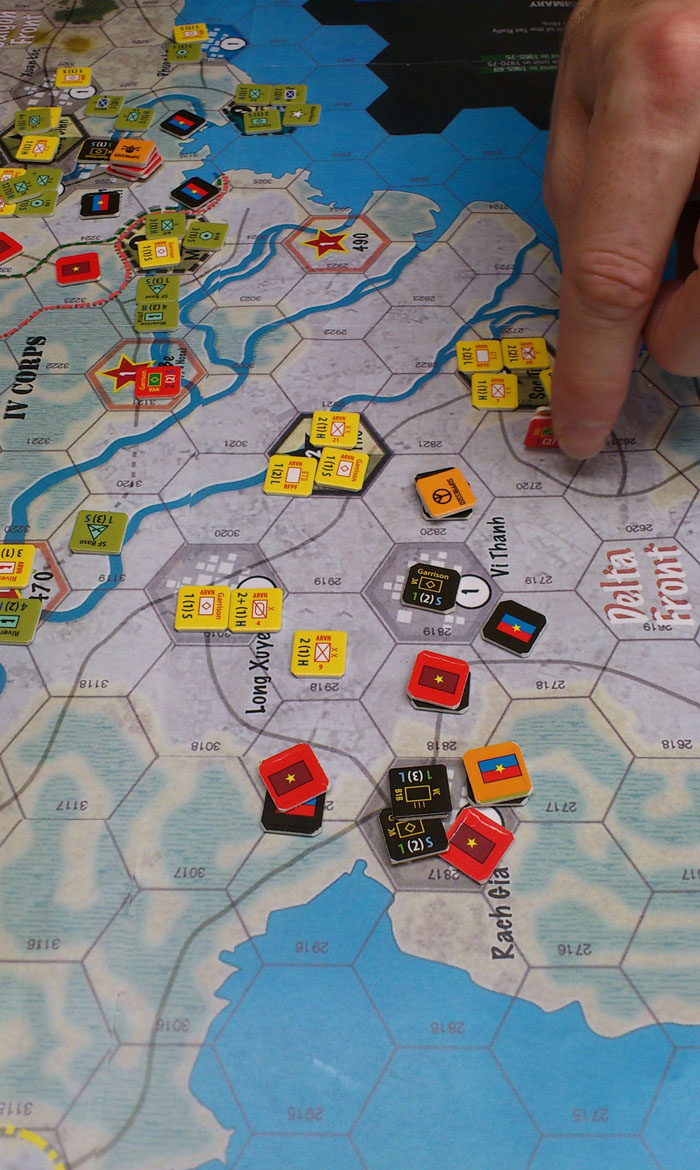
(above photo) Street battles raged in Saigon suburbs and major cities
were under NLF's control. VC/NVA could attack (and had attacked) any kind
of vulnerable targets including bases and cities, even if they had known
the attacking units would be soon destroyed.
I like that asymmetric VP system. For the Communist player, Vietnam is
both conventional and unconventional war, while the US player has to fight
it as conventional one.
The US player had to take cities back before anti-war trend spread on
his country (no more than 25 VP).
NVA/VCは、兵力の弱いところならどこでも攻撃します。自殺攻撃であってもアメリカ軍が得られる政治ポイントは0なので、除去されても苦しくありません。
一方、アメリカ軍ユニットが戦闘によって除去されると、共産軍は政治ポイントを得ます。
共産側にとってベトナム戦争とは手段と犠牲を選ばない非正規戦であり、それに対し、アメリカ軍は正規戦として戦わなければならないのです。
米軍にとって勝利は時間との勝負で、共産軍を上回るスピードで勝利ポイントヘクスを奪回できるかどうかにあります。アメリカ国民が厭戦ムードになる前に勝たなければならないのです。
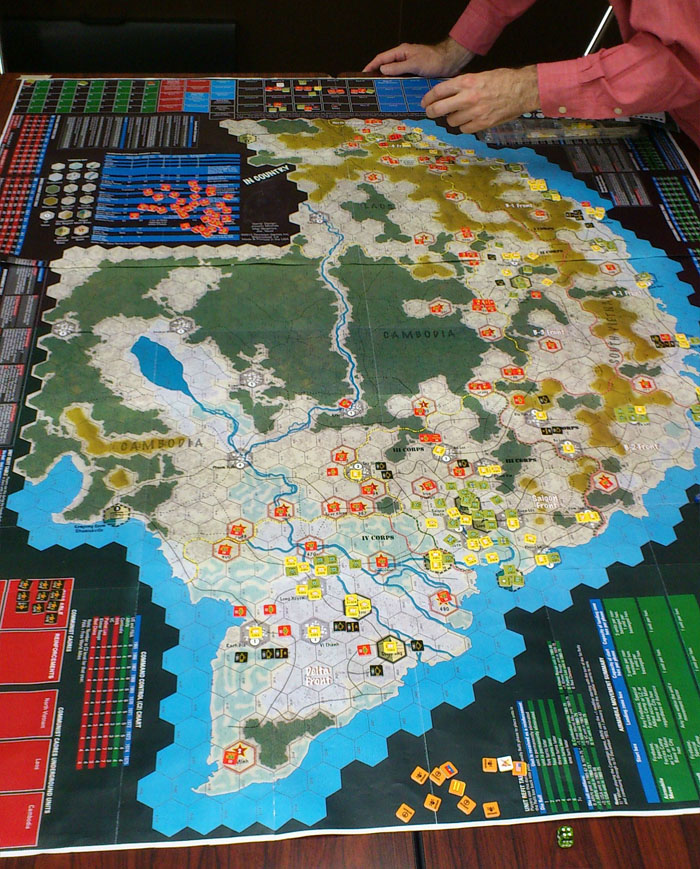
質、量において優る米軍がなぜ勝てなかったのか、上の写真を見ると、その原因の一端が判ります。
NVAユニット(赤)が「聖域」からヒット&ランしています。南ベトナム内にさえ基地があり、VCユニット(黒)の増援を送ることができます。
ミランダの記事では、米軍の敗因は戦術を誤ったことにあるという。
(10/26/2013 YSGAでR氏と対戦)
上記Errataで訂正された主なルール
2013/10/31
- プノンペンのVPは0でなく4
- 「Mobile CRT」の戦闘比1.5-1のダイス6の戦闘結果は「AD」でなく「AW」
- 敵ZOCはLine of Supplyをブロックしない。
- Firebaseはcityへクスに置くことができる。GarrisonユニットのあるCityへクスも可。(しかしSF Campはcityへクスに置けない)
- UndergroundルールによりVCユニットは地下に潜ることができる。
- Operation Phenixルールでアメリカ軍は、上記VCユニットを攻撃できる。
(「Undergroundルール」と「Operation Phenixルール」はConsimに載っています)2013/11/14
「フルシュミレーションルール」と「キャンペーンゲームルール」をConsimで発表 (*゚∀゚)ノ
○国境、corps zoneをカラーリングした300dpiのマップ (jpg)
○iWARIMによるテト攻勢の初期配置例(jpg)
○S&T#126(1989年) 「低強度紛争」